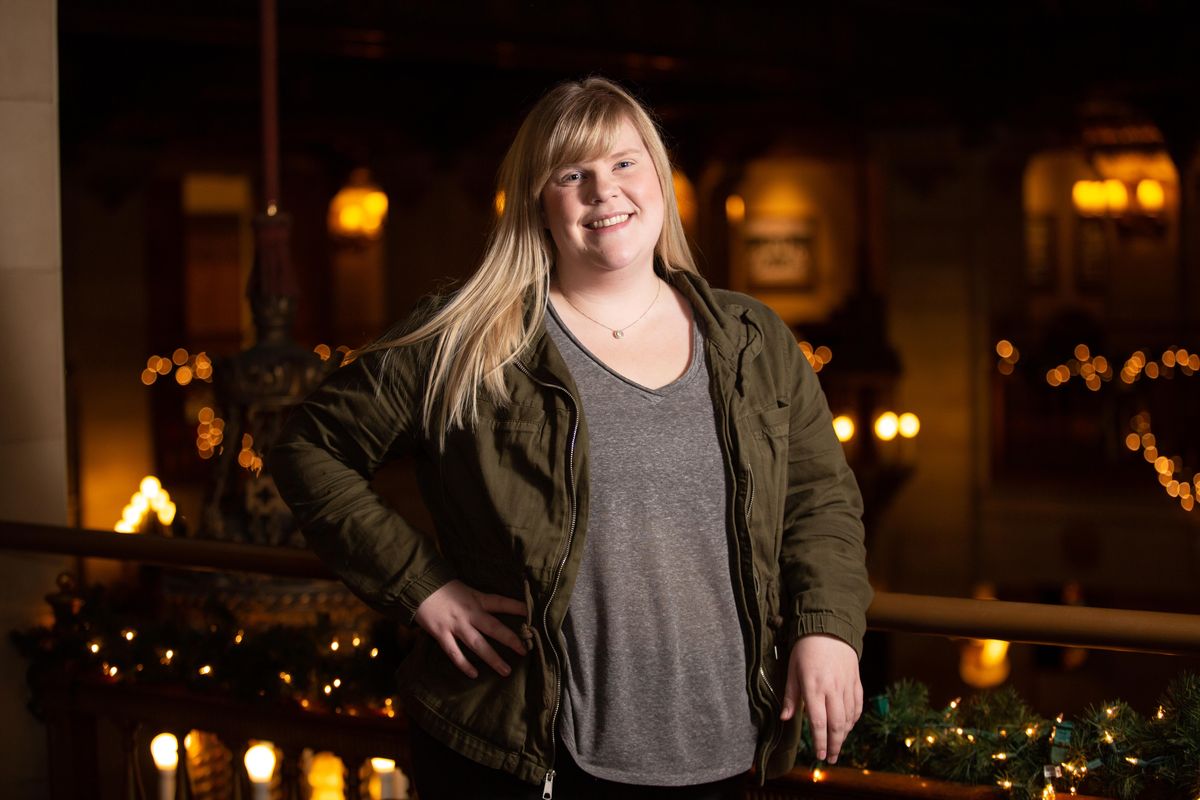Child, twentysomething navigate unpredictability of arthritis; both are raising awareness as honorees in Jingle Bell Run
Amber Fisher poses for a portrait at the Historic Davenport Hotel on Nov. 21, 2018. Fisher is the adult honoree for this year’s Inland Northwest Jingle bell Run on Dec.1, which benefits the Arthritis Foundation. (Libby Kamrowski / The Spokesman-Review)Buy a print of this photo
For Amber Fisher, it was a painful inflamed finger at 17.
For Gracie Coates, it was a horribly swollen knee at 18 months.
Both incidents ultimately led to a diagnosis that changed their lives; rheumatoid arthritis for Fisher and juvenile idiopathic arthritis for Gracie.
On Saturday, the two 2018 Jingle Bell Run-Inland Northwest honorees will be on hand at the annual fun run – an event aimed to raise awareness and funding for those affected by arthritis.
Actually, arthritis is not a single disease; it’s an informal way of referring to joint pain or joint disease. There are more than 100 different types of arthritis and related conditions.
Rheumatoid arthritis was something Fisher, now 27 and a neonatal intensive care nurse at Providence Sacred Heart Medical Center, never anticipated.
“When I was 17, my pediatrician thought my swollen, achy finger was simply sprained,” she said.
But five years later, her right big toe also became inflamed and painful.
“I was hobbling around, maxed out on ibuprofen,” Fisher said. “Lab tests showed my rheumatoid factor was high, and that bought me a one-way ticket to see a rheumatologist who wanted to put me on medication right away. I said, ‘No way. I’m too young to be on meds for the rest of my life.’”
For several years, she was able to manage the disease with diet alone.
“Two years ago, I went on medication because it got to a point where I was flaring up and couldn’t even get my size 8 ring on my finger,” she recalled.
She was training for a half-marathon and had just moved from cardiac care to the NICU.
The choice to go on medication was difficult because she knew it could take many tries and many different combinations to find some relief.
“Every visit with my new doctor ends in tears,” she admitted. “It’s a defeating and annoying process of finding out which combo of meds is going to work. It’s defeating when you feel better, but your labs are the same.”
The Coates family knows that roller coaster well.
A pool party celebrating Gracie’s brother’s birthday turned into a five-day hospital stay, followed by two surgeries for her.
“When I took her out of the pool, her left knee was swollen the size of a softball,” recalled Stephanie Coates, Gracie’s mother.
She rushed her 18-month-old infant to the ER.
Gracie had surgery to drain her knee, and a second surgery to put in a pic line in case she developed an infection.
Six months later, she was diagnosed with juvenile idiopathic arthritis at Seattle Children’s Hospital.
Now, a second-grader at Mullan Trail Elementary in Post Falls, Gracie is direct when asked what she’d like people to know about living with juvenile idiopathic arthritis: “That it comes with a lot of pain,” she said.
Because no local physicians were available to treat children under 8 with her condition, she and her mother make regular trips to Missoula, where they are able to see a doctor from Seattle Children’s Hospital.
Like Fisher, finding the right combination of medication to treat Gracie has been frustrating, expensive and painful.
“I have a new shot,” said Gracie, 7. “It stings a little when my mom does the plunge. They gave me a bumble bee buzzer to distract me, but it didn’t really work.”
So she and her mom came up with their own solution.
“If I blindfold myself, I can’t see it and it doesn’t hurt so bad,” Gracie said.
For now, the latest medication regimen is working.
“Last year I sat out for P.E., but this year I can do it,” she said.
Her mother said this has been Gracie’s healthiest year since her diagnosis. She finally was able to do something most kids her age take for granted. She got to ride a bike.
“I just don’t want her to miss out on anything,” Coates said. “I don’t want her to feel like she’s anything less than amazing.”
But Coates is clear that the diagnosis affects the entire family. Travel and deductibles quickly add up.
“We meet our insurance deductible by February every year,” she said.
And because Gracie’s condition is not readily visible, Coates said she deals with dirty looks if she has to carry her in a store.
Fisher, too, said many people don’t understand about rheumatoid arthritis. She’d like to start a family someday, but that would require careful planning to go off her current medications that would have a toxic effect on the fetus.
Last year she served as a counselor at Kat-Fish Camp, a camp for kids with arthritis.
“Most of the counselors were my age and had arthritis, too,” she said. “I got to chat with peers who understood what I was going through – that’s a pivotal thing.”
Fisher said she’s glad she got involved with the Arthritis Foundation.
“It turned a negative diagnosis into a positive experience,” she said. “Arthritis has no boundaries with age. It’s an invisible illness. People might glance at me, and think there’s nothing wrong, but I’ve learned to celebrate my good days because I know what’s on the other end.”


